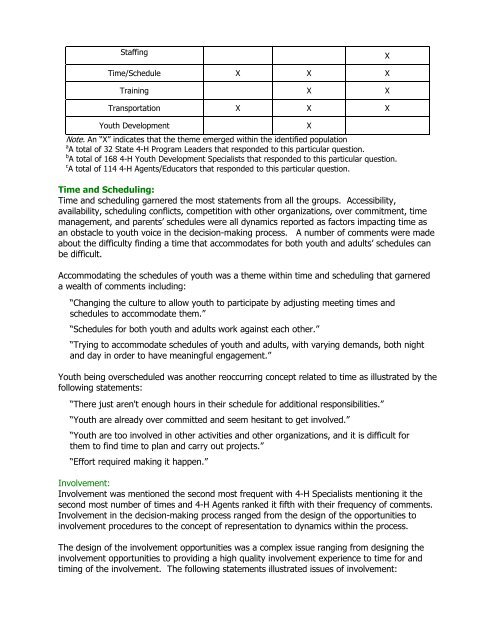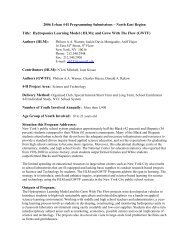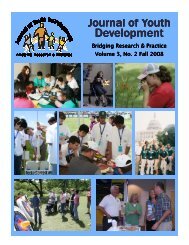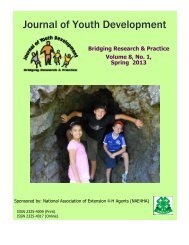Winter 2008 - Vol. 3 No. 3 - National Association of Extension 4-H ...
Winter 2008 - Vol. 3 No. 3 - National Association of Extension 4-H ...
Winter 2008 - Vol. 3 No. 3 - National Association of Extension 4-H ...
- No tags were found...
Create successful ePaper yourself
Turn your PDF publications into a flip-book with our unique Google optimized e-Paper software.
StaffingXTime/Schedule X X XTraining X XTransportation X X XYouth Development<strong>No</strong>te. An “X” indicates that the theme emerged within the identified populationa A total <strong>of</strong> 32 State 4-H Program Leaders that responded to this particular question.b A total <strong>of</strong> 168 4-H Youth Development Specialists that responded to this particular question.c A total <strong>of</strong> 114 4-H Agents/Educators that responded to this particular question.XTime and Scheduling:Time and scheduling garnered the most statements from all the groups. Accessibility,availability, scheduling conflicts, competition with other organizations, over commitment, timemanagement, and parents’ schedules were all dynamics reported as factors impacting time asan obstacle to youth voice in the decision-making process. A number <strong>of</strong> comments were madeabout the difficulty finding a time that accommodates for both youth and adults’ schedules canbe difficult.Accommodating the schedules <strong>of</strong> youth was a theme within time and scheduling that garnereda wealth <strong>of</strong> comments including:“Changing the culture to allow youth to participate by adjusting meeting times andschedules to accommodate them.”“Schedules for both youth and adults work against each other.”“Trying to accommodate schedules <strong>of</strong> youth and adults, with varying demands, both nightand day in order to have meaningful engagement.”Youth being overscheduled was another reoccurring concept related to time as illustrated by thefollowing statements:“There just aren't enough hours in their schedule for additional responsibilities.”“Youth are already over committed and seem hesitant to get involved.”“Youth are too involved in other activities and other organizations, and it is difficult forthem to find time to plan and carry out projects.”“Effort required making it happen.”Involvement:Involvement was mentioned the second most frequent with 4-H Specialists mentioning it thesecond most number <strong>of</strong> times and 4-H Agents ranked it fifth with their frequency <strong>of</strong> comments.Involvement in the decision-making process ranged from the design <strong>of</strong> the opportunities toinvolvement procedures to the concept <strong>of</strong> representation to dynamics within the process.The design <strong>of</strong> the involvement opportunities was a complex issue ranging from designing theinvolvement opportunities to providing a high quality involvement experience to time for andtiming <strong>of</strong> the involvement. The following statements illustrated issues <strong>of</strong> involvement:






